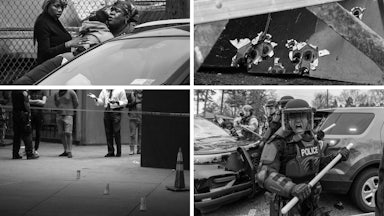In 1975, shortly after moving to Oregon’s Siuslaw National Forest, Carol Van Strum began seeing tank trucks and helicopters spraying something pungent. “No one knew what they were spraying, or what it was for,” she recalled. “A lot of people just assumed, ‘It’s the government doing it, it must be OK.’” It wasn’t. Van Strum’s garden wilted. Her children became sick. Then her dog died. Around the region, women experienced a startling uptick in miscarriages. Fauns were born with no eyes, and frogs were found with extra limbs.
As the damning new PBS documentary The People vs. Agent Orange chronicles, the community soon discovered that the United States Forest Service was showering them with a dangerous herbicide. Known technically as 2,4,5-T, it was one of two key ingredients in the devilish defoliant U.S. forces had layered over much of Southeast Asia during the Vietnam War. In 1971, the military had halted the use of the chemical in reaction to growing public health concerns, yet now, just a few years later, a government agency was deploying a similar cocktail domestically.
Infuriated, and unwilling to let this mass poisoning go unchecked, Van Strum co-founded an activist group, Citizens Against Toxic Sprays, which undertook a community-wide public health survey and, in 1977, secured a temporary injunction against the use of 2,4,5-T. The group also forged bonds with other affected communities, including a town in Idaho where herbicide workers were suffering strange ailments. Some, they learned, even had deformed sperm. Yet just as the grassroots movement was gaining momentum, it was aggressively undermined. Mysterious men in suits trailed activists and tapped their phones. One woman’s home was broken into and all the survey data stored there stolen. Renee Stringham, a physician and an early opponent of the Oregon spraying, recalled being visited by two such men who, in the course of a strange conversation, ominously asked, “Do you know at all times where your children are?”
Van Strum experienced some of the most invasive surveillance. Then, on the night of December 31, 1977, she came home only to find it engulfed in flames. Inside were her four children, aged 5 to 13. All of them died. (The cause of the fire was never determined, though some suspected arson.) Van Strum nearly took her life that night but managed, instead, to channel her grief and anger into her fight against the chemical industry. “The only thing was to keep going,” she explained.
The People vs. Agent Orange makes painfully clear that the story of 2,4,5-T and other dioxins, a class of chemical compound described by one interviewee as inflicting an all-out “assault on the human genome,” is far from over. In 1983, Van Strum’s lawsuit led to a total ban of 2,4,5-T; the other key ingredient of Agent Orange, however, remains on the market. And while post-9/11 veterans were never exposed to this toxic herbicide, many have become sick following exposure on their bases to burn pits that spewed the same dioxins. Like numerous other chemicals, dioxins are by-products of industrial processes—waste incineration, for example, or paper processing. Consequently, they’ve been viewed as inevitable, even negligible, side effects of American capitalism and military primacy. Today, the Environmental Protection Agency views dioxins as among the most dangerous pollutants on the planet, and regulators have cracked down on their production. But because of their once-prolific production and two-billion-year half-life, dioxins, at this point, can be found in all the earth’s elements: soil, water, air, and fire.
How has such a vast poisoning gone practically unnoticed by the public? The People vs. Agent Orange describes a concerted campaign of misinformation, legal muscle, and dirty tricks on the part of the chemical industry to avoid scrutiny and shirk liability. And indeed, willful ignorance or outright malfeasance accompanied the use of Agent Orange from practically the beginning. In Operation Ranch Hand, which kicked off in 1961, soldiers sprayed nearly 20 million gallons of the herbicide across Southeast Asia. (To accomplish this mission, the U.S. government essentially federalized the chemical companies Dow and Monsanto to produce endless drums of the stuff.) A National Security memo from the time described Ranch Hand as a plan that would kill two birds with one stone: It would at once deny cover to the enemy and deny them food. Quite quickly, however, troubling third- and fourth-order effects emerged, from rashes and rare cancers to birth defects. And just as quickly, the evidence was quashed.
In fact, scientists raised grave concerns about Ranch Hand as early as 1964. In February 1967, 5,000 of them, including 29 Nobel laureates, presented a letter to President Lyndon Johnson demanding he stop what they considered a barbaric form of biowarfare. And in May 1971, an Air Force scientist, Dr. James Clary, completed a stunning report on the herbicide campaign that indicated serious health problems for many exposed to Agent Orange. “I finished my report, and it was immediately classified ‘Secret,’ and the government kept it locked up for over 35 years and denied that it even existed,” Clary contends in the film. “It was tantamount to a cover-up,” adds former U.S. Senate Majority Leader Thomas Daschle.
After Ranch Hand ended, political and industry leaders continued to claim that dioxins were harmless. In 1979, Dr. Cleve Goring, a researcher with Dow Agriculture, said the herbicide was “as toxic as aspirin.” (Belying Goring’s claim was Dow’s own internal research, including a 1965 memo expressing serious concerns over 2,4,5-T’s numerous “toxic impurities.”)
Leaning on this willful ignorance, chemical companies continued to pump, dump, and spray dioxins and other dangerous chemicals across the world. In 1977, the military incinerated a whopping 1.4 million gallons of surplus Agent Orange in the South Pacific Sea. In 1982, Times Beach, Missouri, was made a ghost town after the discovery of massive dioxin contamination tied to the defunct chemical factory in the area.
With sweeping shots of environmental degradation and horrifying testimonials from victims, The People vs. Agent Orange expertly links the plight of the natural world to its people. In doing so, it refutes a long-held but foolish industry talking point: that herbicides only hurt the trees.
Only in recent years has the government acknowledged the truth about dioxins. The Department of Veterans Affairs today offers health care and compensation for those sickened by the chemicals, while Congress has appropriated nearly $400 million in aid to Vietnam. Thousands of veterans, however, have been illegitimately denied benefits, while affected children of exposed veterans are ineligible for assistance. The size of the support for Vietnam is also a pittance for a country with one million sick citizens.
In 2019, a congressional staffer told me that the foreign aid faced “stiff resistance” from Obama staffers and Pentagon lawyers who were worried it would set a significant precedent. “Their position was, ‘We don’t want to start down this road because then everyone is going to knock on our door and ask us to make good on damage done,’” the staffer explained. Indeed, as The New York Times revealed earlier this year, America has refused even to acknowledge Ranch Handers’ spraying of Laos, although it’s explicitly confirmed in military records.
The legal system has been similarly resistant to acknowledging or regulating the widespread use of Agent Orange. A big blow came in 2008, when the Supreme Court, without explanation, declined to hear a series of cases from Vietnam veterans and Vietnamese citizens seeking accountability. In May, a French court dismissed the case of Tran To Nga, a subject in the documentary who has liver cancer following direct exposure to the herbicide.
Strikingly similar stories have emerged around other poison potions produced by Dow and Monsanto, including chlorpyrifos, which cause brain damage, and glyphosate-based pesticides, which have been tied to cancer. “Time and time again, big companies have found ways to avoid liability for knowingly endangering people so they can add to their profits,” explained Sharon Lerner, an Intercept journalist.
Because the pernicious effects of these substances often show themselves slowly—and are so widespread—few will be able to prove harm or secure a settlement. Even in the rare instances when victims secure financial penance, there remains an element of inadequacy. No check can compensate for the time lost and damage wrought by these compounds. Few know this better than Dewayne Lee Johnson, a former groundskeeper who developed a terminal case of non-Hodgkin’s lymphoma after being doused with the Monsanto weed killer Roundup. While Johnson recently secured a $20.5 million payout, he will never obtain what he truly wants: more time with his boys. “There are only so many things you can buy,” he explained in a 2018 op-ed.
America’s prevailing political, economic, and legal attitudes subvert the rights of life and nature in favor of corporations. In recent years, some countries have begun fighting back by imbuing rivers, mountains, and glaciers with full legal rights, a precedent Van Strum is herself trying to set. As part of an ongoing case to uphold her county’s 2017 ban on aerial pesticides, she has declared herself a representative of the Siletz River ecosystem. “Like the Lorax, I speak for the rights of waters and forests and wildlife to challenge human violations of natural law,” she contended in a legal filing.
As troubling health and environment data continues to pile up, the true scope of dioxins’ legacy becomes ever clearer. The People vs. Agent Orange, which masterfully captures this ongoing damage, should renew a debate about the use of these chemicals. But the film’s own thesis suggests such action is unlikely. Time and again, activists, regulators, scientists, and politicians have been ignored. Van Strum’s work has yielded results, but she is certainly a Lorax-like figure. Like the Seuss character, her warnings have fallen on deaf ears as the forest is savaged.








